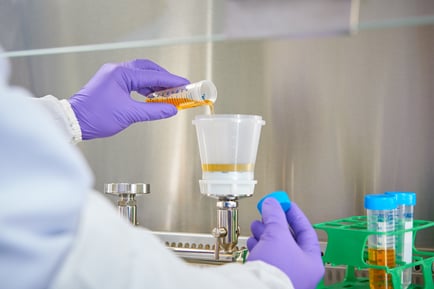blog
June 10, 2022 | Source: Rapid Micro Biosystems, Inc.
Ask Rapid: Automation of Bioburden Testing
POSTED BY Rapid Micro Biosystems | 5 minute read
June 10, 2022 | Source: Rapid Micro Biosystems, Inc.
POSTED BY Rapid Micro Biosystems | 5 minute read
Answering your questions about the Growth Direct® System.

With recent shutdowns of pharmaceutical facilities making headlines worldwide, contamination detection now poses even tougher speed and safety demands. Automated bioburden testing has consequently attracted the interest of many industry professionals, particularly in our Growth Direct® System. Do you need to become more efficient in your bioburden testing, while removing sources of human error and improving data integrity? If so, this edition of “Ask Rapid” might have the answers you’re looking for.
How does the Growth Direct® System get the same results as the traditional method?
The Growth Direct® System for bioburden testing is not an alternative method, but rather an automated version of the existing method that analyzes the natural autofluorescence of growing cells and tracks growth over time. Testing monitors colony forming units (CFU) across the same broad range of species as are detected by the visual colony counting method, while distinguishing growing microbial colonies from inanimate fluorescent debris that cannot change in signal intensity or size. Sample preparation mirrors the existing filtration method, with the added advantage that data from the Growth Direct® System can be seamlessly integrated into laboratory information management systems (LIMS).
Is actionable reporting available?
Yes. Configurable action and alert limits provide the lab with updates when samples are out of the configured specification, allowing faster response to potential contamination events. Automated alerts can be sent out to analysts around the clock, 24/7.
Can I validate in-process bioburden sample testing with the Growth Direct® System?
Certainly. As an automated colony counter applied to pharmaceutical in-process bioburden testing, the Growth Direct® System uses a proven strategy with a simplified verification approach that follows the process defined in the USP <1223> to show acceptability for in-process product testing. The four steps to validation are:
What is the time to results for bioburden tests?
Studies show that the Growth Direct® System uncovers positive results within hours of testing and provides final results in about half the time of a traditional test – by 36 hours rather than the 3-5 days required with the traditional method, or even as early as 16 hours if the action level is 1 CFU.
I have an odd sample that cannot filter. Will it work on the Growth Direct® System?
In many instances, techniques have been developed to filter products that usually cannot be filtered. Our team can perform a study on your product to determine if it can be used on the Growth Direct® System.
Where can I learn more?
For extensive data on use of the Growth Direct® System in bioburden testing, try this article:
If you have specialized questions, simply contact Rapid Micro Biosystems today. We’ll be happy to help you learn more about automating your bioburden testing.